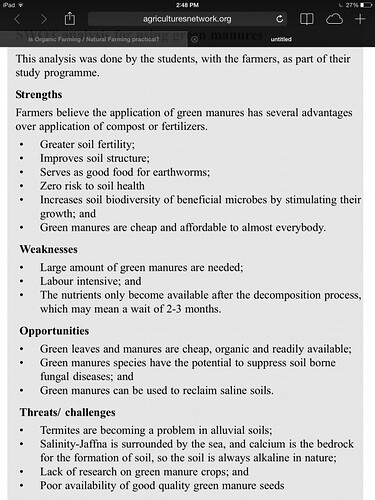Hi Prash,
To be honest, after what I wrote later on in the day I felt I might have offended or hurt the feelings of some, and was going to write an apology a few days back. I got this feeling within me I shouldn’t have written that. I only wrote to help prevent youth going into unexpected problems. So I apologize.
You are correct in everything you said, its not easy and it would be better if one gave good guidance instead, and I am not an expert. There are youth with good intentions doing everything they can to teach themselves in a sincere way despite the constraints, like lack of finances, lack of trustworthy genuine mentors, foolish laws that make farming difficult, lack of family support etc.
You are correct the key is selecting good fertile land to purchase. When buying land can you take an experienced farming elder that can help you identify good fertile soil? Someone in this forum said red soil is best. There was a post on how to select good farm land in this forum.
In this article on green manure, it explains how farmers in Sri Lanka test soil fertility.
"The timing of application of green leaf manure depends on the moisture content of the soil. Farmers measure this by digging to a depth of 5cm, and taking a soil sample. They make a clod by pressing the soil between their hands. If the clod breaks up immediately, this indicates insufficient soil moisture. If there is enough moisture in the soil, farmers will start to add green manure.
Farmers also have their own method of detecting soil fertility. They refer to the organic matter content as “soil fat”, characterised by the sticky nature of the soil. If they find that the soil is not very sticky, they confirm that the soil is less fertile, and will use green manures. To test for fertility, some farmers press their feet into the soil – if they can do this easily, they believe it is rich in organic matter content. Otherwise it needs to be supplemented with green manure or farmyard manure."
It said the best green manure for soil remediation for saline soils is ragi and tamarind leaves.
agriculturesnetwork.org/maga … prove-soil
Another article on green manure.
researchgate.net/profile/Ami … c9e183.pdf
Maybe Navadanya in Mumbai can give suggestions?
This is an organic farm just outside of Mumbai. They give tours.
ecovillage.org.in/activities … tices-gev/
youtube.com/watch?app=deskto … BELY1xzr_8
This is their organic product list
ecovillage.org.in/Gev-Brochures/ … oducts.pdf
In Tamil Nadu the agricultural university has an organic farming website and you tube videos that might give some ideas.
agritech.tnau.ac.in/org_farm/orgfarm_index.html
PLEASE NOTE:
I have no direct personal experience working with most of the links I suggested in this forum. It’s only from my personal readings I find them, so be careful. Some people in the organic or conservation field are more motivated by politics and money, than genuine purpose, they are con artists. This I did experience.

